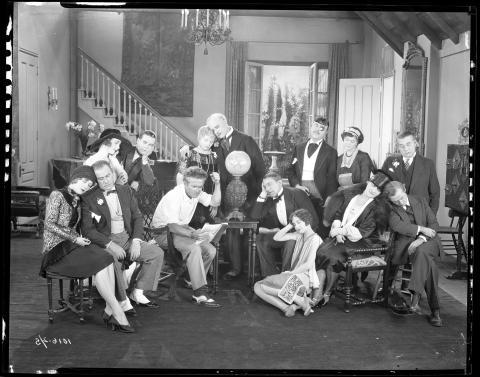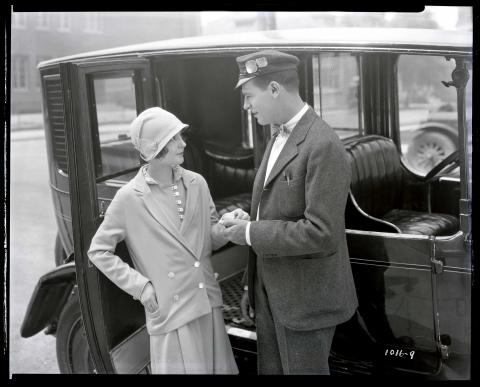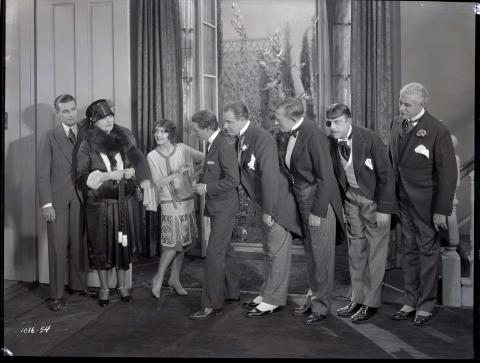
Jimmy Chang is a processing assistant working on the "Inventing Hollywood: Preserving and Providing Access to the Papers of Renegade Genius Howard Hughes" joint project sponsored by the UNLV Libraries Special Collections and Archives and the UNLV Department of Film, which is funded by a generous grant from the National Endowment for the Humanities.
According to some versions of the story, early reviewers considered Swell Hogan (1926), Howard Hughes’ first film, so bad that it convinced him to halt the release of the film. Undaunted, Hughes tried again to establish a Hollywood presence by acquiring the rights to Everybody’s Acting (1926), a film produced and directed by Marshall A. Neilan. Despite achieving modest success as Hughes’ first successfully distributed picture, Everybody’s Acting is as of 2022, a ‘lost film,’ or a film with no known surviving copies.
How was the film created? What did the film even look like? Thanks to surviving film stills, a continuity outline, and a mixture of financial and legal papers found in the Howard Hughes Film Production Records (MS-01036), researchers can uncover at least some of the story behind Hughes’ second venture into filmmaking.
The continuity outline for Everybody’s Acting from 1926 is possibly one of the only remaining copies. While no known film currently exist, the combination of production stills and a screenplay help piece together the plot.

Everybody’s Acting tells the story of a woman, orphaned as a baby and adopted by an acting troupe, who finds love through unexpected circumstances with help from her adoptive fathers. While this functions as a synopsis, what more can be uncovered about a film that cannot be seen?
In the case of Everybody’s Acting, the film stills contain numbers on their corners, denoting the possible sequence in which they were taken. It was then discovered that the film stills contained intermittent publicity photographs and missing sequential shots. The narrative gaps can be filled in using the continuity outline. Used in tandem with the continuity outline, the photographs provide visuals while the text gives dialogue, direction, and descriptions of events throughout the film not depicted in the still images. Each component informs the other, providing a more comprehensive understanding of the film despite the absence of the original moving images.
Financial reports for Everybody’s Acting describe administrative film expenditures and payments to actors and supporting staff. The reports provide insight into the film’s production process, and as some of the oldest papers in the collection, they also detail the cost and types of expenditures for a typical 1920s film including wardrobe, payment amounts to specific film positions, and equipment required to film at the time.
The reports also list people key to the Everybody’s Acting production and distribution, highlighting behind-the-scenes individuals less prominent than the film’s principal actors. These names include some early female film editors, such as Helene Wayne, credited for work in film such as The Spanish Dancer (1923) and Wild Oats Lane (1926), and Martha Dresback, credited for work in films including Night Life in Reno (1931) and Tabu (1931). Also included are individuals involved in post-production such as Margaret Ettinger, a press agent and owner of the Margaret Ettinger Publicity advertising firm.

Despite being lost for nearly a century, it is now possible to piece together not just the plot, but the process of producing Everybody’s Acting using materials found in The Caddo Company series of the Howard Hughes Film Production Records. Compared to his later controversial films, these records detail Howard Hughes’ first ventures into Hollywood as fairly simple romantic comedies and reveal his earliest creative visions.
"Inventing Hollywood: Preserving and Providing Access to the Papers of Renegade Genius Howard Hughes" is a joint project sponsored by the UNLV Libraries Special Collections and Archives and the UNLV Department of Film, and is funded by a generous grant from the National Endowment for the Humanities.
About the National Endowment for the Humanities
Created in 1965 as an independent federal agency, the National Endowment for the Humanities supports research and learning in history, literature, philosophy, and other areas of the humanities by funding selected, peer-reviewed proposals from around the nation. Additional information about the National Endowment for the Humanities and its grant programs is available at: www.neh.gov.


